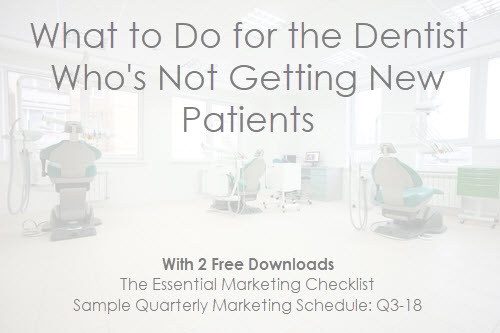(Don’t miss the two free downloadable marketing documents to help you with getting new patients. See below!)
Sometimes I get calls from frustrated dentists who have good web traffic, but their new patient numbers fall short of goals. Instead of 20-30, they’re seeing fewer than 10 new patients per month, and they can’t figure out the problem.
Well, the silver lining is that we know there IS a problem, so that’s where we start.
The issue is not with the dental website, if we see good traffic on Google Analytics, and that traffic is originating from the right location.
The source of not getting new patients could be difficult to locate, but with logic and patience, we can ferret it out.

For one client in particular, the issue seemed to be getting patients into the office. “Once they’re here, they seem happy,” she said. So, retention is good. That means the staff is doing their job, and the ambiance and atmosphere in the practice pleases the patients. The doctor makes patients happy.
The issue must be:
- website conversion – getting web visitors to call the office and book an appointment
- or phone conversion – getting callers to book an appointment
- or cancellations – potential patients not following through with new patient visits
To track this, we must collect data. This is often the neglected task that leaves dentists in the dark about why they aren’t seeing new patient numbers. Without data, without facts, the source of the problem will remain a mystery. You could guess at the reasons, but you’d have no proof. Any actions for a remedy would be trial and error based. To save time and money, simply track data, then evaluate it, like any good scientist!
On the website side, we need to look at the analytics and see where visitors are leaving the website.

On the office side, we need the office manager to do two things.
- Chart where first-time callers heard about the office
- Record how many first-time bookings are following through with appointments
After collecting that data for 60-90 days, we’ll know more about the actual source of our problem, so we can work toward finding solution.
Holistic Dental Marketing
With that said, creating a holistic marketing plan can help a practice develop an environment that embraces marketing as part of its day-to-day business, rather than a separate (almost third-party) venture. I’ve created a few documents that will help can weave a holistic marketing philosophy into your practice.
The Essential Marketing Checklist
The first is a series of brief checklists reviewing marketing points of various types. It covers the basic foundational elements, from practice name and mission statement to ideal patient and logo design. All other points are divided into two primary categories: external marketing (out of office) and internal marketing (inside the office).
While you certainly do not need to employ every point on these checklists, most of them will prove extremely valuable to getting new patients. (Note that I left off radio and television, because these must be organized through a third party.)
The Essential Dental Marketing Checklist

Quarterly Scheduling of Marketing Duties
Watch Mad Men, and you’ll see that advertising, and marketing, used to entail a few radio and TV ads, and a lot of word of mouth. There were fewer people in towns and fewer dentists, too. Dentists had no competition! Only cigarettes and automobiles needed advertisements. Oh, how times have changed.
Today, dentists need a website, direct mailers, and great signage, as well as community involvement, patient referrals, Google reviews, and Facebook posts. Every dentist competes for patients, whether he/she wants to admit it or not. To keep an office’s schedule full, 20 new patients a month is the average requirement, due to attrition in our mobile society.
I’ve created a quarterly marketing schedule to share with you. It will seem daunting to most dentists, at first. However, such a schedule will help you or your designated delegate brainstorm, plan, organize, and maintain a marketing plan and its many responsibilities. If you stick to this kind of schedule, you WILL see more new patients. The longer you stick to it, the more new patients you’ll see.
Sample Dental Marketing Schedule

Cost of Dental Marketing
After looking at the checklist and schedule, you’re surely wondering just how much this is going to cost. Ten years ago, a well-known and highly regarded dental consultant stated that the cost of acquiring a new patient was approximately $200. From what I recently read, a CPA will advise spending just 1% of your gross profit on internal marketing, plus about 10K per year, while an advertising professional will recommend an established practice spend 15% and a new practice spend up to 30% of projected gross profits. A dental consultant – arguably the most objective of the bunch – will suggest 5 to 10% of profits. I believe 10% is a reasonable number for a dentist who wants to maintain a moderate level of growth.
There is much to be said for outsourcing the duties to an expert, like my team at Identiwrite Creative, though some dentists prefer to have a marketing expert on staff. The most cost-effective marketing staff members know how to manage a practice website and social media and can also handle PR within the community.

Identiwrite Creative Will Help with Getting New Patients
If you’re interested in holistic dental marketing or need experienced copywriters to compose well optimized, clinically accurate text for your website or blog, call on the experts at Identiwrite Creative! I’m Shauna Duty, the owner, and I’ll be happy to discuss your practice marketing plan. You can text or call me at 940-395-5115, or email me at [email protected].



